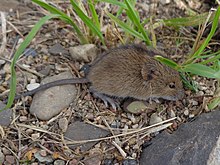| Northern birch mouse | |
|---|---|

| |
| Conservation status | |
 Least Concern (IUCN 3.1) | |
| Scientific classification | |
| Domain: | Eukaryota |
| Kingdom: | Animalia |
| Phylum: | Chordata |
| Class: | Mammalia |
| Order: | Rodentia |
| Family: | Sminthidae |
| Genus: | Sicista |
| Species: | S. betulina |
| Binomial name | |
| Sicista betulina (Pallas, 1779) | |

| |
The northern birch mouse (Sicista betulina) is a small rodent about 5 to 8 cm long (without the tail), weighing 5 to 13 g. It lives in northern Europe and Asia in forest and marsh zones.
It hibernates in burrows. It eats shoots, grains, berries, and sometimes insects.
Description
The northern birch mouse is a small mouse with a relatively long tail. The adult head and body length is 2 to 3 in (51 to 76 mm) with a tail of 3 to 4.25 in (76 to 108 mm). Adults vary in weight between 5 and 13 g (0.2 and 0.5 oz). The upper parts are yellowish-grey with a brown sheen and the underparts are a pale greyish-yellow. A black stripe runs along the spine from the head to the base of the tail. Its voice is a high-pitched whistle.
Distribution and habitat
The northern birch mouse occurs in Scandinavia, Central and Eastern Europe, and Northern Asia. Its main range extends from the Baltic region, Poland and the Czech Republic eastwards as far as Lake Baikal in Siberia, and from the Arctic Circle southwards to the Carpathians. Isolated populations occur in Norway, Sweden, Denmark, Germany, and Austria. Its natural habitat is coniferous forests, mixed deciduous woodland, marshy woodland, and damp bushy grassland, and it is sometimes found in cereal crops.
Biology
The northern birch mouse is largely herbivorous and feeds on buds, shoots, grass seeds, and berries, but it also takes earthworms, insects, and snails, often finding these under loose bark. It is a skillful climber and often clambers around in trees and shrubs, gripping the twigs and branches with its five-toed feet and using its prehensile tail for additional support.
In the summer, the northern birch mouse makes a nest of dry vegetation in a bush, clump of moss, or tussock of grass. Breeding takes place between May and August, and a single litter of up to six young is produced after a gestation period of 4–5 weeks. This mouse hibernates in winter, seeking out a natural crack or the burrow of another animal, in a dry location such as on an embankment or in a bushy place. Other sites chosen can be in a hollow tree, in a tree stump or fallen log, or in a gap under a rock. During the hibernation period, which may last from October to May, the tail is wrapped spirally around the animal's body.
Status
The northern birch mouse has a very large range. In Western Europe, it is generally uncommon with isolated subpopulations, but further east it is very common. Its population trend is unknown, but the IUCN lists the species as being of least Concern, as it considers that it is unlikely to be declining at such a rate as to justify including it in a more vulnerable category. No specific threats to this mouse have been identified, but agriculture may affect its numbers in Germany, and deforestation may affect it in Romania.
See also
References
[REDACTED] Scholia has a topic profile for Northern birch mouse.- ^ Meinig, H.; Zagorodnyuk, I.; Henttonen, H.; Zima, J. & Coroiu, I. (2008). "Sicista betulina". IUCN Red List of Threatened Species. 2008. Retrieved 18 May 2014.{{cite iucn}}: old-form url (help)
- Holden, M.E.; Musser, G.G. (2005). "Family Dipodidae". In Wilson, D.E.; Reeder, D.M. (eds.). Mammal Species of the World: A Taxonomic and Geographic Reference (3rd ed.). Johns Hopkins University Press. pp. 887–888. ISBN 978-0-8018-8221-0. OCLC 62265494.
- ^ Konig, Claus (1973). Mammals. Collins & Co. pp. 142–143. ISBN 978-0-00-212080-7.
- ^ Olsen, Lars-Henrik (2013). Tracks and Signs of the Animals and Birds of Britain and Europe. Princeton University Press. p. 204. ISBN 9781400847921.
| Taxon identifiers | |
|---|---|
| Sicista betulina |
|